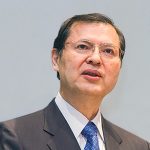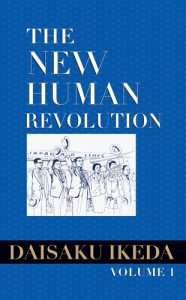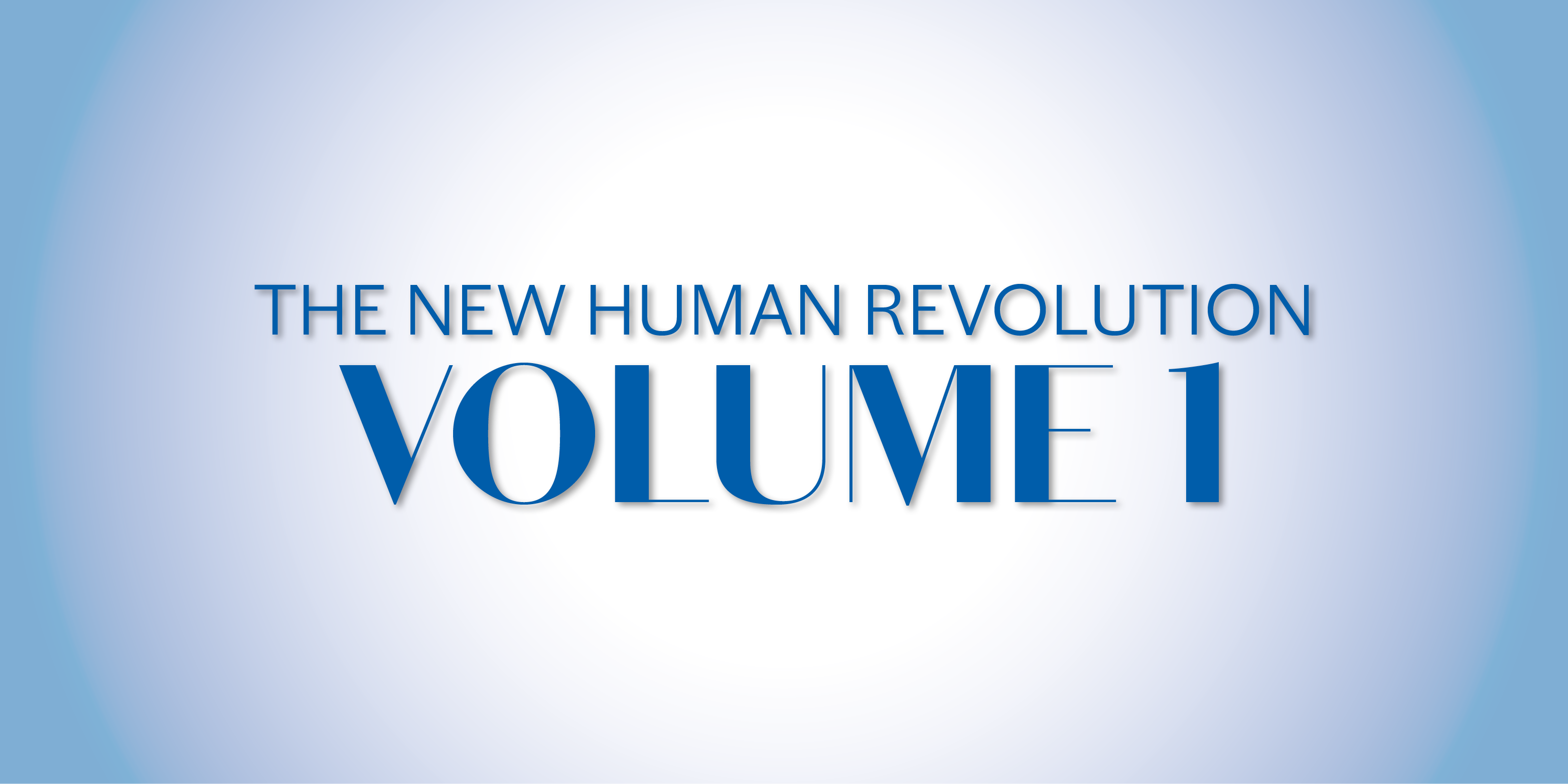 In the introduction to volume 1 of The New Human Revolution, SGI President Ikeda describes two main reasons for writing it:
In the introduction to volume 1 of The New Human Revolution, SGI President Ikeda describes two main reasons for writing it:
What inspired me to write The New Human Revolution series as a continuation of The Human Revolution was my thought that the extent to which kosen-rufu has unfolded since my mentor’s passing serves as genuine proof of his greatness. In addition, to transmit my mentor’s spirit for eternity, I felt that I must leave a record of the path his disciples, who inherited his legacy, have followed.[1]
In other words, for President Ikeda, writing The New Human Revolution was part of his effort, as a disciple, to attest to the greatness of his mentor, second Soka Gakkai President Josei Toda, and ensure that his spirit would endure into the eternal future.
Whereas The Human Revolution begins with the chapter titled “Dawn,” The New Human Revolution commences with the chapter “Sunrise.” Although both “Dawn” and “Sunrise” are words associated with the sun, their nuances differ slightly. Dawn means the first appearance of daylight, whereas sunrise occurs after the dawn.
In The Human Revolution, President Ikeda describes how daylight had broken in President Toda’s heart alone. In other words, President Toda realized that he was a Bodhisattva of the Earth and took action based on this. What we see in The New Human Revolution is the way this is inherited by his disciple Shin’ichi Yamamoto (representing President Ikeda in the novel), who proceeds to advance worldwide kosen-rufu with the vigor and momentum of a rapidly rising sun.
Volume 1 of The New Human Revolution was first published in book form in Japanese on January 2, 1998, President Ikeda’s 70th birthday. Two days later, the first installment of his essay series “Thoughts on The New Human Revolution” was carried in the Seikyo Shimbun. In this first essay, he reflects on his achievements over the previous decades and sets forth his goals and objectives for the next decade, as well as outlining a vision for the future:
If I were to set down what I had accomplished from the age of 60 to the present, along with what I envisage for the decade ahead, it would read as follows:
To the age of 70: The establishment of the principles of a new humanism.
To the age of 80: The completion of the foundations for worldwide kosen-rufu.
From that point on, in accord with the Mystic Law and the undying and unaging nature of life expounded in Buddhism, I am determined to take the lead in kosen-rufu throughout eternity.[2]
In the epilogue to volume 1, President Ikeda writes, “I intend to carry out my work, speaking and taking action, for as long as I live, and to continue writing The New Human Revolution as if it were my final testament.”[3] I cannot help but feel that, in writing The New Human Revolution, he sought to record the spirit of the three founding presidents of the Soka Gakkai for future generations and for all eternity.
Each Person Is a Diamond in the Rough
I would next like to suggest three perspectives from which to study volume 1 of The New Human Revolution.
The first perspective is the historical background to the events being described. In 1960, the year in which Shin’ichi takes his first step toward worldwide kosen-rufu, the world was in tumult, as was Japan. With the Cold War at its height, the threat of nuclear weapons was intensifying everywhere, while at home, opinion was divided over amending the U.S.-Japan Security Treaty. In the U.S., racial discrimination was rife, while Japanese immigrants living in Brazil also faced numerous hardships. We thus see that the guidance Shin’ichi offers in this volume is based on the larger context of the country or community in question.
The second perspective is the way The New Human Revolution chronicles the emergence of a global religious movement. We see in volume 1 how Shin’ichi strives to find ways to concretely advance worldwide kosen-rufu, a task entrusted to him by his mentor, even when others don’t understand.
In San Francisco, he appoints two men, one of whom is not even a member, to be advisors to the district. He also decides to establish a district in Nevada upon meeting a married couple who had traveled from there to see him. With regard to these arrangements, President Ikeda writes:
None of [Shin’ichi’s] decisions or responses was made on a mere impulse or whim. Even split-second decisions contained his concentrated thought for kosen-rufu that came from exerting infinitely painstaking effort in each moment of life.[4]
Shin’ichi continues his travels for peace, chanting Nam-myoho-renge-kyo in his heart everywhere he visits for the happiness of his friends and the prosperity of their communities. “He was determined to permeate the new land of America with his chanting, offering prayers for its prosperity.”[5]
Such earnest prayers and the immense effort of traveling to nine cities in three countries during a span of 24 days resulted in the establishment of two chapters and 17 districts, paving the way for the Soka Gakkai’s development as a global religious movement.
The final perspective is how the task of accomplishing worldwide kosen-rufu ultimately starts with encouraging the individual in front of us. After all, though districts and chapters may be established, it is the people who are at the heart of the organization.
While in San Francisco, a Japanese leader accompanying Shin’ichi laments that there is a lack of capable individuals, to which Shin’ichi replies: “They are all capable people. They will begin to shine from here on. If they persevere with pure-hearted faith, their names will all go down in the annals of kosen-rufu as pioneers.”[6]
During his visit to Chicago, Shin’ichi speaks to a group of women awaiting his return in the hallway of the hotel where he is staying. Despite their somewhat shabby appearance, Shin’ichi proceeds to wholeheartedly encourage them, seeing each one of them as a Buddha.
We should never judge a person by their outward appearance or social status. Also, regardless of whether someone practices Nichiren Buddhism or not, we should put our whole heart into every encounter and always strive to cultivate friendships. This is the core belief that Shin’ichi’s behavior embodies, an attitude I believe each of us needs to embrace.
The Spirit of Forging Ahead
In “Sunrise,” second Soka Gakkai President Josei Toda says: “Shin’ichi, you must live! You must live as long as you can and travel the globe!”[7]
In the phrase “travel the globe” (Jpn sekai ni iku), the Chinese character President Ikeda uses to express “travel” has an unusually active nuance of “boldly advance” or “forge ahead”—implying not just the action but also the spirit behind it.
President Ikeda regarded the call for him to “travel the globe” as the starting point of a ceaseless journey for peace with his mentor. Toward the end of the final chapter of volume 1, he writes: “His trip was about to end. But this trip was but a beginning of an endless journey for peace.”[8]
The lyrics of the “Song of Human Revolution” include the same character used in the word “travel” above: “Forge ahead, and I will forge ahead, too, / pressing on through blizzards, we boldly advance.” Let us, too, forge ahead on an unending journey for peace, together with our mentor, by studying The New Human Revolution.
Translated from the October 31, 2018, issue of the Seikyo Shimbun, the Soka Gakkai’s daily newspaper.
Summary of Contents
 Sunrise
Sunrise
On October 2, 1960, Shin’ichi Yamamoto departs for North and South America. His visit to Hawaii marks the first step of his journey for worldwide kosen-rufu.
A New World
In San Francisco, Shin’ichi suggests three guidelines, which become a solemn vow for the Japanese members living in America.
Golden Autumn
In Chicago, Shin’ichi is struck by the stark reality of racial discrimination. He also visits Canada.
Light of Compassion
Districts are established in New York and Washington, D.C.
Pioneers
Despite deteriorating health, Shin’ichi visits Brazil and establishes the first chapter outside Japan.
This book is available at https://bookstore.sgi-usa.org.
References
- The New Human Revolution, vol. 1, revised edition, p. x. ↩︎
- January 2018 Living Buddhism, p. 21. ↩︎
- Translated from Japanese. Daisaku Ikeda, Shin ningen kakumei (The New Human Revolution), vol. 1 (Tokyo: Seikyo Shimbunsha, 1998), p. 353. ↩︎
- The New Human Revolution, vol. 1, revised edition, p. 108. ↩︎
- Ibid., p. 171. ↩︎
- Ibid., p. 117. ↩︎
- Ibid., p. 3. ↩︎
- Ibid., p. 315. ↩︎
You are reading {{ meterCount }} of {{ meterMax }} free premium articles

